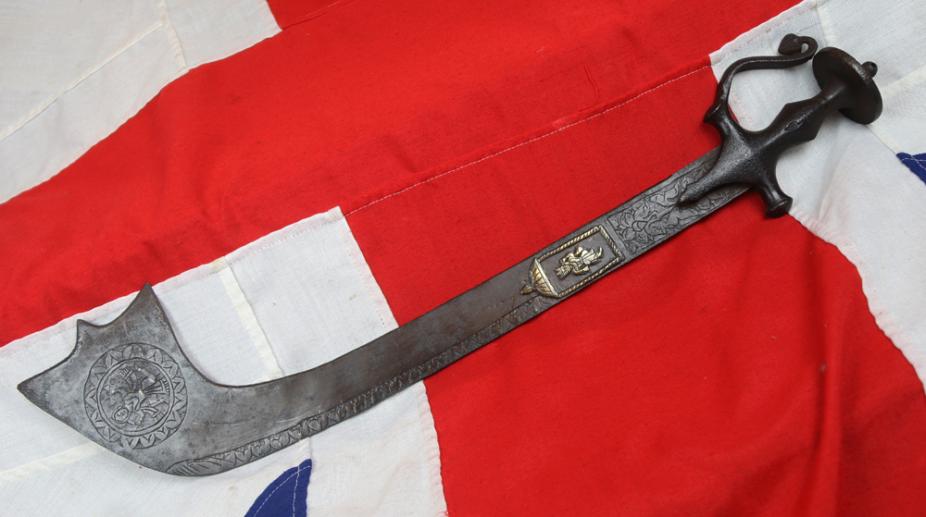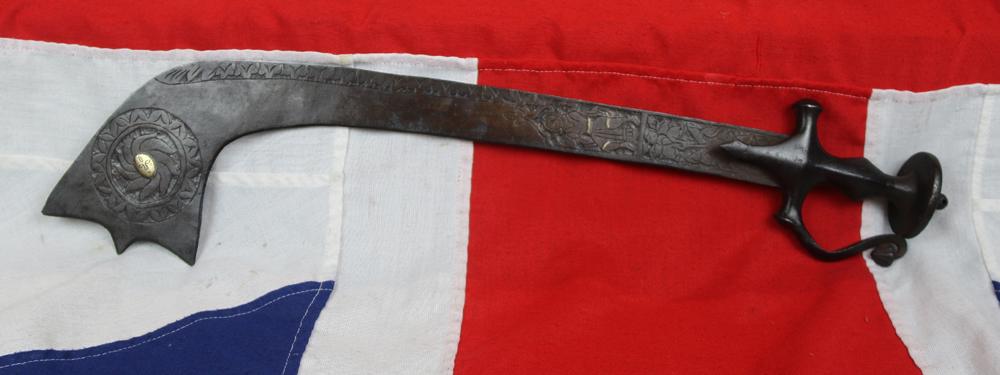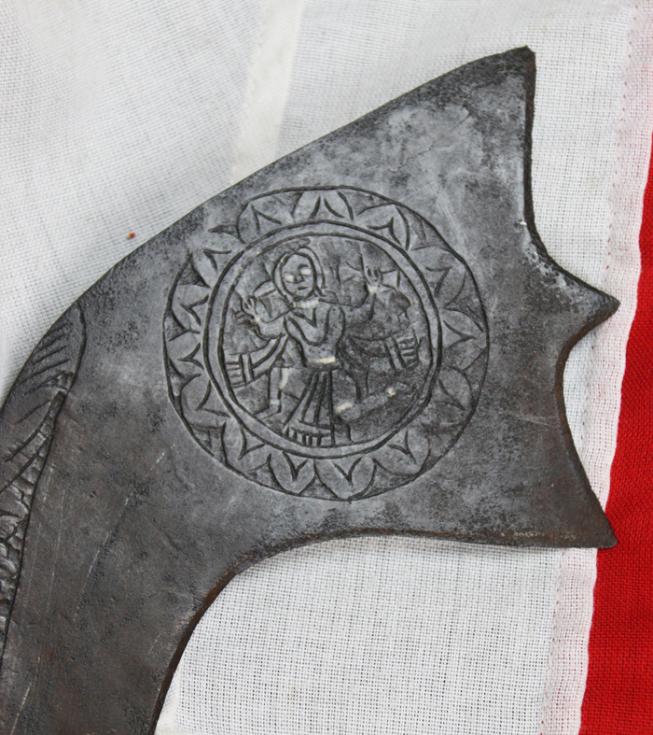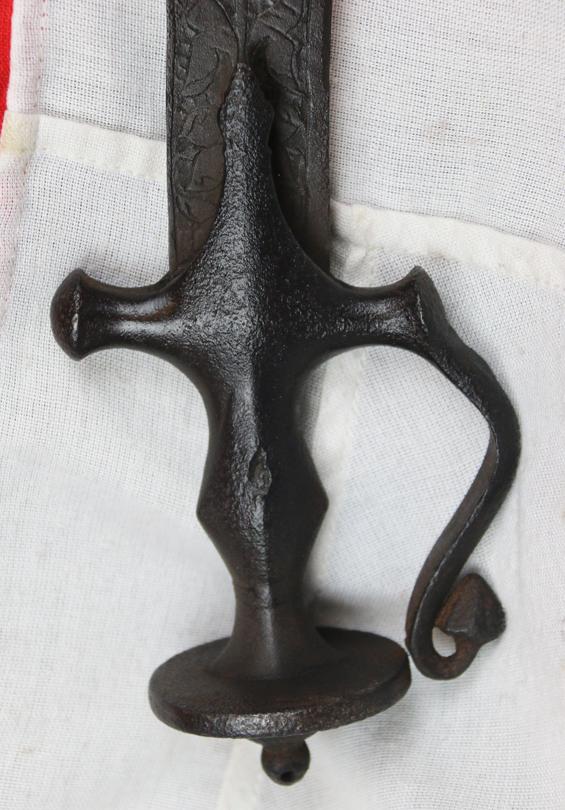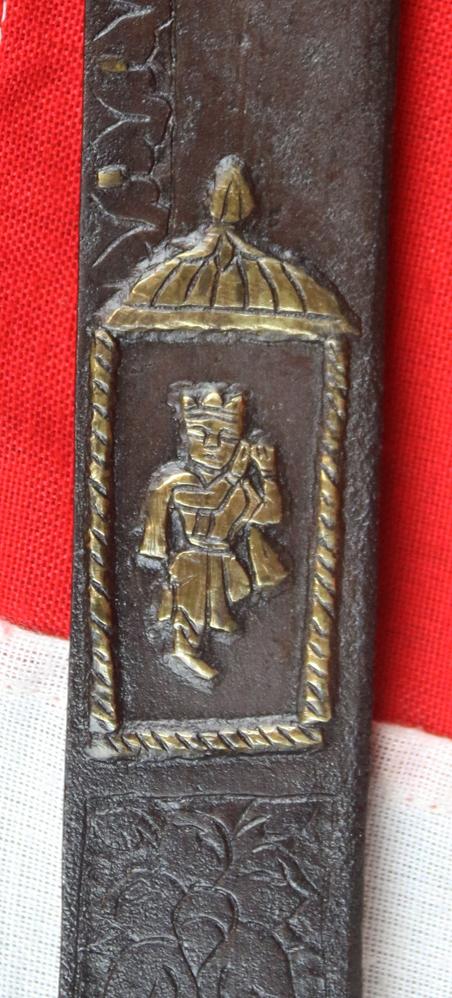A Superb & Very Rare Sword, From the Indian Sub Continent. A Beautiful 18th Century Kora With Krishna Inlay
All steel inlaid with brass bronze embellishments of with chased brass and copper-overlaid figural decoration, depicting Krishna playing the flute inside a domed shrine chhajjas, domed pavillion-shaped structure,
The Kora is the second best known weapon of Nepal, the first being the legendary Kukri (Khukuri), both are national weapons of Nepal. The third forward curved blade of Nepal is the Ram Dao, it is only used in religious affairs and was doubtfully used in times of war. Like Nepal, the Kora & Kukri are strongly associated with the Gurkhas and was firstly illustrated in Col. William Kirkpatrick's work "An Account of the kingdom of Nepaul" published in London, 1811 based on his travels in 1793 to Nepal.
There both the Kukri and Kora is for the first time illustrated to the wider worlds public. The Kora was traditionally used warfare and personal protection, but also played and still plays a function in the religious sphere where it is used to behead sacrificial animals in one blow, otherwise believed to bring bad fortune and the sacrifice is considered useless. Thus both a skilled man and a formidable blade is needed, the Kora certainly passes the criteria! Lord Egerton and Rawson share the main idea that the forward curved blade most likely goes back to the Egyptian Khopesh and from there over to the Grecco-Roman world where it was called Kopis. Most authors, collectors and people with knowledge will agree on this, so far it's the best option we have. So much of the past, its history is forgotten, unrecorded and often only minor fragments remain.
Krishna
Krishna, Sanskrit Kṛṣṇa, one of the most widely revered and most popular of all Indian divinities, worshipped as the eighth incarnation (avatar, or avatara) of the Hindu god Vishnu and also as a supreme god in his own right. Krishna became the focus of numerous bhakti (devotional) cults, which have over the centuries produced a wealth of religious poetry, music, and painting. The basic sources of Krishna’s mythology are the epic Mahabharata and its 5th-century-CE appendix, the Harivamsha, and the Puranas, particularly Books X and XI of the Bhagavata-purana. They relate how Krishna (literally “black,” or “dark as a cloud”) was born into the Yadava clan, the son of Vasudeva and Devaki, who was the sister of Kamsa, the wicked king of Mathura (in modern Uttar Pradesh). Kamsa, hearing a prophecy that he would be destroyed by Devaki’s child, tried to slay her children, but Krishna was smuggled across the Yamuna River to Gokula (or Vraja, modern Gokul), where he was raised by the leader of the cowherds, Nanda, and his wife Yashoda.
The child Krishna was adored for his mischievous pranks; he also performed many miracles and slew demons. As a youth, the cowherd Krishna became renowned as a lover, the sound of his flute prompting the gopis (wives and daughters of the cowherds) to leave their homes to dance ecstatically with him in the moonlight. His favourite among them was the beautiful Radha. At length, Krishna and his brother Balarama returned to Mathura to slay the wicked Kamsa. Afterward, finding the kingdom unsafe, Krishna led the Yadavas to the western coast of Kathiawar and established his court at Dvaraka (modern Dwarka, Gujarat). He married the princess Rukmini and took other wives as well.
Krishna refused to bear arms in the great war between the Kauravas (sons of Dhritarashtra, the descendant of Kuru) and the Pandavas (sons of Pandu), but he offered a choice of his personal attendance to one side and the loan of his army to the other. The Pandavas chose the former, and Krishna thus served as charioteer for Arjuna, one of the Pandava brothers. On his return to Dvaraka, a brawl broke out one day among the Yadava chiefs in which Krishna’s brother and son were slain. As the god sat in the forest lamenting, a huntsman, mistaking him for a deer, shot him in his one vulnerable spot, the heel, killing him.
Code: 23295
795.00 GBP


